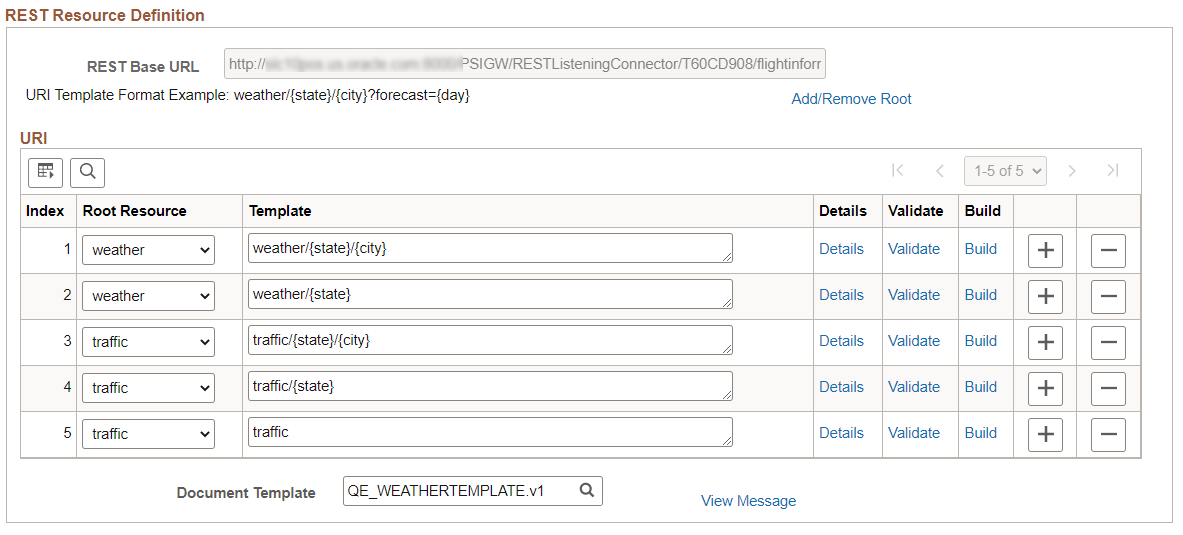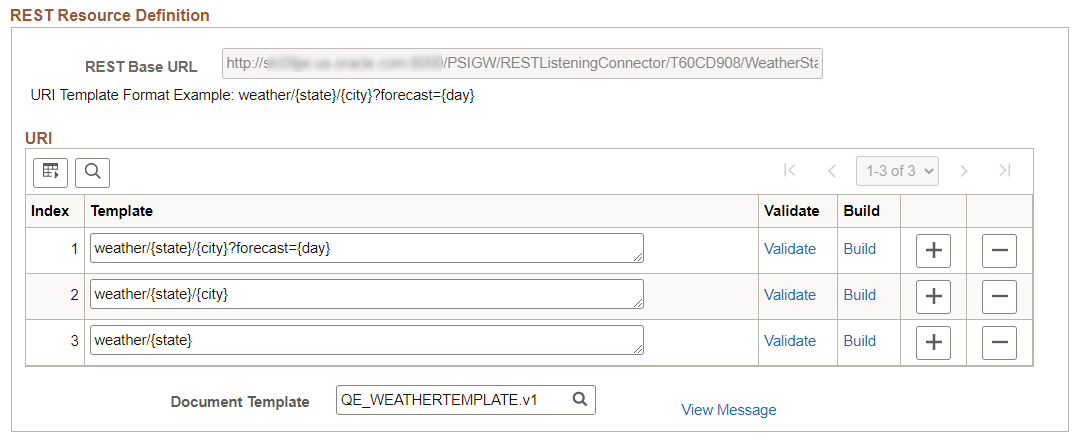Viewing REST Service Operation Definitions
The Service Operations component includes three pages - General, Handler and Routings.
|
Field or Control |
Description |
|---|---|
|
General Tab |
Features general-service and default-service operation information. This page also features REST resource definition information. The REST Resource information section differs depending on whether or not it is an OpenAPI REST service. |
|
Handlers Tab |
Provides summary information about handlers that have been added to an operation. Service operation handlers contain the programming logic for sending and receiving service operations and their contained messages, and for manipulating content. Note that handlers are not used for REST consumer-based service operations and the Handler tab does not appear when you view or work with a consumer REST service operation. |
|
Routings Tab |
Provides summary information about service operations routings. Routing definition determine the direction — inbound, outbound — of service operations. |
The Service Operations General page differs depending on whether or not OpenAPI is selected.
The top portion of the General page contains basic information about a service operation, including its name, description, and so on.
The Service Operation Security link opens the permission list for the service. Note that the Service Operation Security link appears only after a service operation definition is saved.
This example illustrates the top portion of the Service Operations General page.

The REST Resource definition section for an Open API REST Service Operation requires Root Resources. For each Root Resource, it is necessary to define the details for each index.
The REST Resource Definition section for an Open API REST displays the REST base URL, as well as the resources defined for the service operation, and the name of the document template associated with the service operation. A link is also provided to View the Document Template message.
This example illustrates the REST Resource Definition Section for an Open API Rest Service.

|
Field or Control |
Description |
|---|---|
|
Add/Remove Root |
The Add/Remove Root link opens the Add/Remove Root Resources page. |
|
Details |
The Details link opens the URI Template Details page which contains the message.version for Request, Response and Fault messages |
|
Validate |
The Validate link opens the Validate URI page. |
|
Build |
The Build link open the URI Template Builder page. |
See Managing REST Resource Definitions for Open API REST Service and Defining REST Base URLs.
The Default Service Operation Version section contains the current active and routing status. You can regenerate routings, by select the appropriate check box and saving the page.
This example illustrates the Default Service Operation Version section for an Open API REST Service Operation

For REST Service Operations that do not use Open API, the same message versions are used for all URI indexes.
The REST Resource Definition section displays the REST base URL, as well as the resources defined for the service operation, and the name of the document template associated with the service operation. A link is also provided to View the Document Template message.
This example illustrates REST Resource Definition section for REST Service that does not use Open API.

For more information see Defining REST Base URLs and Managing REST Resources.
This example illustrates the Default Service Operation Version where Open API is not selected for the REST Service.

This section displays the current active and routing status. You can regenerate routings, by select the appropriate check box and saving the page.
The Runtime Schema Validation group box shows if runtime schema validation is selected for the request and response message.
The Routing Status group box shows the routing statuses that exist.
The Routing Actions Upon Save group box allows you to regenerate routings.
The Message Instance section displays the request message, response message information, and fault message for the service operation. The View Message links in this section open the displayed message on the Message Definition page, where you can view additional information about the message.
The Handler page defines the Application Class that provides the processing logic for the service operation.
To view service operation handler information, click the Handlers tab. Doing so displays the Service Operations - Handlers page (IB_SERVICEHDLR) which lists summary information about handlers that have been added to an operation.
Each REST-based provider service operation has a single handler; REST-based consumer service operations do not have handlers.
Note: There are no handlers for REST-based consumer service operations and the Handler tab does not appear when you view and work with consumer REST service operations.
The only handler Type available for provider REST services is the OnRequest handler. When working with REST provider service operations you can implement the OnRequest handler as an application class only. The application class is implemented as any other OnRequest integration broker event.
This example illustrates the Handler page

The summary information includes the handler name, the handler type, and the implementation method for the handler. The status of the handler, active or inactive, also appears.
Use the Details link to view the Handler details.
This example illustrates the Handler Detail page

The Routings page provides a summary of routing definitions for a service operation.
Click the Routings tab to open the Service Operations - Routings page (IB_SERVICERTNGS) to view a summary of routing definitions for an operation.
This example illustrates the Routings page.

The Routings Definition grid on the page lists summary information for routings that are defined for a service operation. Summary information that is displayed includes the routing definition name, service operation version, routing type, sending node, receiving node, direction of the routing and the routing status.
Click a routing definition name to open the routing in the Routing Definitions component, where you can view additional information about the routing.
When you create a provider REST service operation the system automatically creates an any-to-local routing. You can also generate local-to-local routings for a provider REST service operation.
See Viewing Routing Definitions in Graphical Format.
You can also use this page to activate or inactivate routings for an operation.
See Adding Routing Definitions, Activating and Inactivating Routing Definitions.